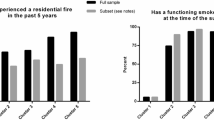Abstract
Residential structure fires pose a significant risk to life and property. A major source of these fires is the ignition of upholstered furniture by cigarettes. It has long been established that cigarettes and other lighted tobacco products could ignite upholstered furniture and were a leading cause of fire deaths in residences. In recent years, states have adopted fire standard compliant cigarettes (‘FSC cigarettes’) that are made with a wrapping paper that contains regularly spaced bands, which increases the likelihood of self-extinguishment. This paper measures the effectiveness of FSC cigarettes on the number of residential fires involving upholstered furniture, and the resulting fatalities, injuries, and extent of flame spread, while accounting for the under-reporting of fire incidents. In total, four models were estimated using fire department data from 2002 to 2011. The results provide evidence that FSC cigarettes, on average, reduced the number of residential fires by 45%, reduced fatalities by 23%, and extent of flame spread by 27% in 2011. No effect on injuries was found. Within each state, effectiveness is moderated by the number of smokers and their consumption patterns. In general, FSC cigarettes are more effective in places with a large smoking population who engage in heavier smoking. There is a very limited effect on the lightest of smokers, suggesting behavioral differences between heavy and light smokers that influence fire risk.









Similar content being viewed by others
Notes
These cigarettes are also known as ‘fire-safe cigarettes’ and ‘fire standard compliant cigarettes’.
In NFIRS, extent of flame spread is recorded for non-confined fires as either: (1) confined to room of origin, (2) confined to floor of origin, (3) confined to building of origin, or (4) beyond building of origin.
For purposes of this analysis, residential fires included all NFIRS incidents with a property use codes beginning with a ‘4’ (residential) and an incident type code 111 (building fire, excluding confined fires).
Flame spread is reported as either: confined to object of origin, confined to room of origin, confined to floor of origin, confined to building of origin, or beyond building of origin.
A weighted average was used to aggregate each count into a single metric. The weighting weighted confined to object of origin as zero up to beyond building of origin as four.
References
Ahrens M (2011) Home fires that began with upholstered furniture. National Fire Protection Association. http://www.nfpa.org/research/reports-and-statistics/fire-causes/household-products/upholstered-furniture. Accessed 19 April 2016
Hall JR (2015) Estimating fires when a product is the primary fuel but not the first fuel, with an application to upholstered furniture. Fire Technol 51:381–391
Thomas DS, Butry DT (Forthcoming) Identifying residential fires involving upholstered furniture within the National Fire Incident Reporting System. NIST Technical Note 1845. National Institute of Standards and Technology, Gaithersburg
National Fire Protection Agency (2011) States that have passed fire safe cigarette laws. http://www.nfpa.org/safety-information/for-consumers/causes/smoking/coalition-for-fire-safe-cigarettes/states-that-have-passed-fire-safe-cigarette-laws. Accessed 19 April 2016
Hall JR (2013) The smoking-material fire problem. National Fire Protection Association. http://www.nfpa.org/research/reports-and-statistics/fire-causes/smoking-materials. Accessed 19 April 2016
National Cancer Institute (2016) Tobacco use supplement to the current population survey (TUS-CPS). National Cancer Institute. http://appliedresearch.cancer.gov/tus-cps/info.html. Accessed 19 April 2016
Federation of Tax Administrators (2012) The tax burden on tobacco, historical compilation, volume 47. http://www.taxadmin.org/fta/tobacco/papers/tax_burden_2012.pdf. Accessed 20 Nov 2015
Butry DT, Prestemon JP, Thomas DS (2014) Investigation of the decline in reported smoking-caused wildfires in the USA from 2000 to 2011. Int J Wildland Fire 23:790–798
King BA, Patel R, Babb SD (2014) Prevalence of smokefree home rules—United States, 1992–1993 and 2010–2011. Morb Mortal Weekly Rep 63(35):765–780
National Fire Protection Association (2014) Changes in area of origin in home structure fires started by smoking materials. https://community.nfpa.org/external-link.jspa?url=http%3A%2F%2Fwww.nfpa.org%2F%7E%2Fmedia%2FFiles%2FResearch%2FFact%2520sheets%2FChangeInAreaofOriginSmokingMaterialFactSheet.pdf. Accessed 27 July 2016
Frazier P, Schaenman P, Jones E (2011) Initial evaluation of the effectiveness of reduced ignition propensity cigarettes in reducing cigarette-ignited fires: case studies of the North American experience. http://www.fdma.go.jp/html/life/yobou_contents/info/pdf/tabaco/kentou01/sanko04.pdf. Accessed 19 April 2016
Contenta D (2010) Cigarette smuggling rises in Canada. http://www.globalpost.com/dispatch/canada/091201/cigarettes-smuggling. Accessed 19 April 2016
CBS News (2000) Tobacco’s other secret. http://www.cbsnews.com/news/tobaccos-other-secret/. Accessed 19 April 2016
Shults CA (2014) Smoking-related fires and the impact of the fire standard compliant legislation in the States. Dissertation, University of Tennessee
Folz DH, Shults CA (2014) When the smoke clears: the impact of state fire-safe cigarette policies on reducing fire fatalities. Int Fire Serv J Leadersh Manag 8:31–42
Alpert HR, Christiani DC, Orav EJ, Dockery DW, Connolly GN (2014) Effectiveness of the cigarette ignition propensity standard in preventing unintentional residential fires in Massachusetts. Am J Public Health 104(4):e56–e61
Yau RK, Marshall SW (2014) Association between fire-safe cigarette legislation and residential fire deaths in the United States. Inj Epidemiol 1(10): 1–6
Bonander CM, Jonsson AP, Nilson FT (2016) Investigating the effect of banning non-reduced ignition propensity cigarettes on fatal residential fires in Sweden. Eur J Public Health 26(2):334–338
Vuong QH (1989) Likelihood ratio tests for model selection and non-nested hypotheses. Econometrica 57(2):307–333
Consumer Product Safety Commission (2008) Standard for the flammability of residential upholstered furniture: proposed rule. Federal Registry 73(43):March 4
Author information
Authors and Affiliations
Corresponding author
Rights and permissions
About this article
Cite this article
Butry, D.T., Thomas, D.S. Cigarette Fires Involving Upholstered Furniture in Residences: The Role that Smokers, Smoker Behavior, and Fire Standard Compliant Cigarettes Play. Fire Technol 53, 1123–1146 (2017). https://doi.org/10.1007/s10694-016-0621-3
Received:
Accepted:
Published:
Issue Date:
DOI: https://doi.org/10.1007/s10694-016-0621-3




